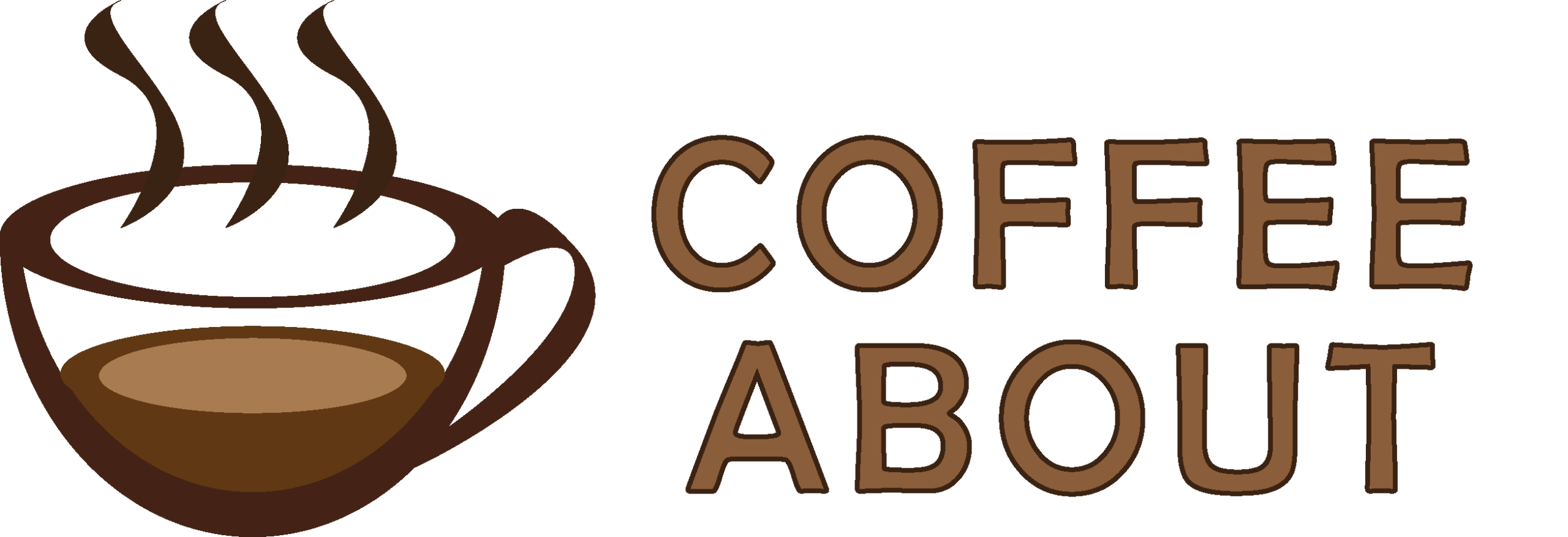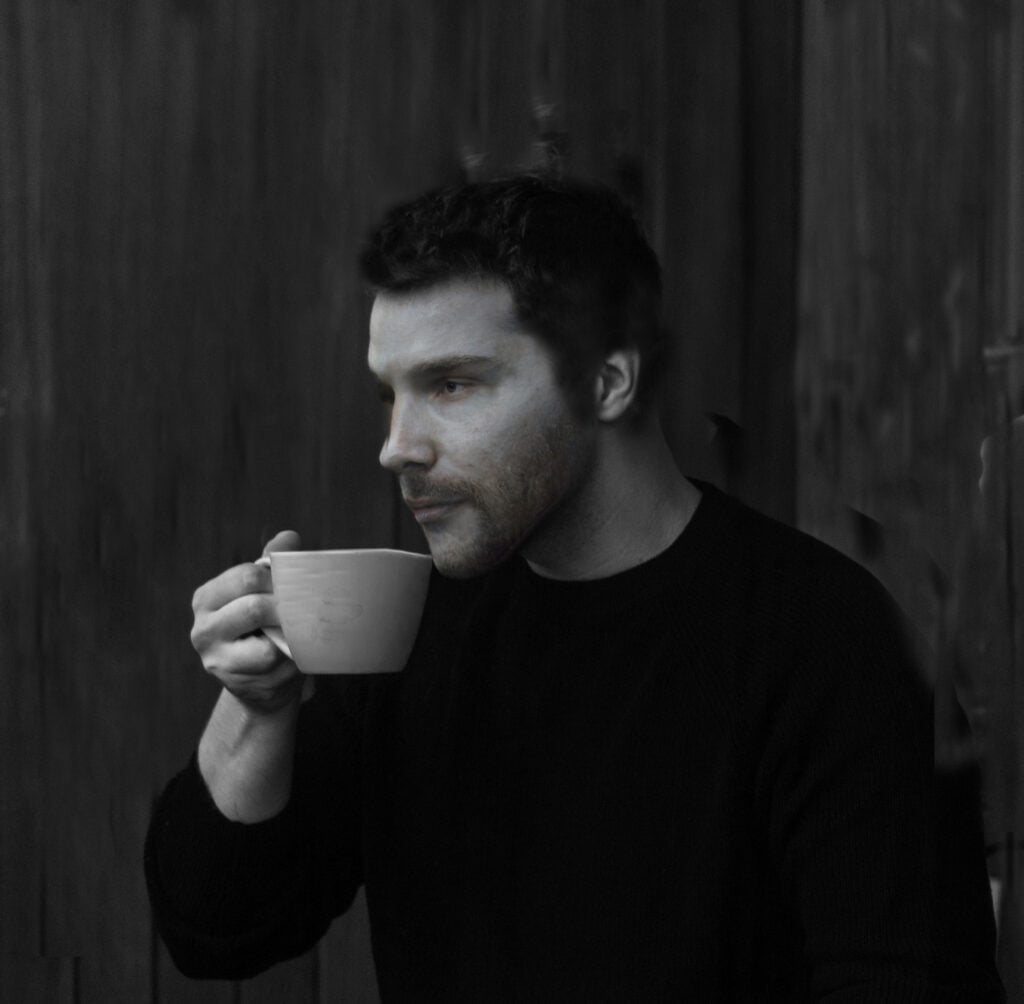Third Wave coffee is a movement that treats coffee like an art, not just a drink. It focuses on using high-quality beans, ethical farming practices, careful roasting, and handmade brewing methods. Every step, from growing the beans to serving the cup, is done with care to highlight the coffee’s natural flavors and unique story.
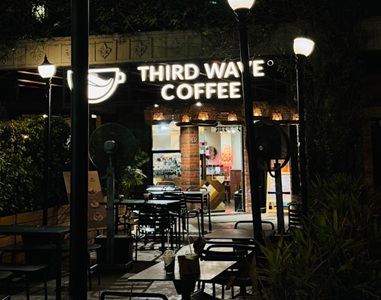
Coffee has come a long way from quick, instant cups to thoughtfully brewed drinks that highlight flavor and origin. Today, more people are choosing hand-crafted coffee that tells a story, and that’s where third wave coffee comes in.
This modern movement is about enjoying the taste, appreciating where your coffee comes from, and treating it like a craft. From the farm to your cup, every step matters.
In this blog, we’ll explain what third-wave coffee is, how it’s different from the older styles, and why it’s winning the hearts of true coffee lovers around the world.
What is 3rd Wave Coffee?
Third-wave coffee is a movement that focuses on treating coffee like a special, handmade product rather than an everyday commodity. This wave started in the early 2000s, and it values high-quality beans, ethical sourcing, precise brewing, and an overall better coffee experience. It’s not just about a caffeine fix — it’s about taste and knowing the story behind every cup.
The third-wave also highlights where the coffee comes from, how it’s roasted, and how it’s served. People in this movement care about the farm, the farmer, and the unique flavors of each coffee bean.
some Features of third wave coffee
Specialty single-origin beans
Single origin beans stand at the heart of the 3rd wave coffee revolution. These beans come from one specific farm, region, or country, allowing you to taste the unique characteristics of that place.
The volcanic soil of Ethiopia produces berries with bright, fruity notes, while Colombian beans often carry chocolate and nut undertones. Sumatran coffees from Indonesia provide earthy and herbal qualities, characterized by low acidity and a full body. Meanwhile, Panama’s renowned Gesha variety is celebrated for its delicate floral aromas, reminiscent of jasmine and bergamot.
This traceability connects you directly to the farmers and their distinct growing methods.
Focus on Sustainability and Direct Trade
Third wave coffee is reshaping the entire coffee industry through sustainability and direct trade practices. Roasters now skip traditional middlemen and work directly with farmers, creating relationships that benefit everyone in the supply chain.
When you buy direct trade coffee, you’re supporting farmers who receive fair compensation for their hard work. These higher prices allow producers to invest in better growing practices and improve their communities. Many farms now implement water conservation methods, shade-growing techniques, and organic cultivation to protect local ecosystems.
Third wave companies like Counter Culture, Intelligentsia, and Stumptown regularly visit their partner farms, developing long-term relationships instead of simply looking for the cheapest beans.
Artisanal Roasting Techniques
Instead of roasting huge batches, third-wave roasters use small-scale artisanal techniques. They use small-batch drum roasters that give them precise control over temperature profiles, bringing out each bean’s unique characteristics. Plus, they often list the roast date right on the bag, so you know it’s fresh.
Third wave roasters are focused on light to medium roasting profiles, stopping the roast before caramelization dominates the flavor. This lighter approach preserves the bean’s terroir and unique flavor compounds that would otherwise be lost in darker roasts. You’ll hear them talk about “development time” and “first crack” – the exact moment when beans expand and release their oils and aromas.
They use digital tools to track every temperature change while roasting, which helps them create “roast curves” they can recreate for consistent results[1]. This scientific method works hand in hand with the roaster’s senses; they’re always smelling, looking, and later tasting their brews during “cupping sessions” to perfect what they do.

Precision Brewing Techniques
3rd wave coffee takes precision brewing seriously. Baristas now measure coffee with gram scales, use timers to track extraction, and maintain specific water temperatures—all to unlock the full potential of specialty beans.
You’ll see pour-over methods like Hario V60 and Chemex dominating countertops, where baristas control every variable with specialized kettles that regulate water flow. The Specialty Coffee Association actually publishes brewing standards that many cafés follow, specifying ideal coffee-to-water ratios and extraction percentages.
Even espresso preparation has evolved; baristas now use pressure profiling machines to adjust extraction pressure throughout the shot and dial in every grind size and extraction time.
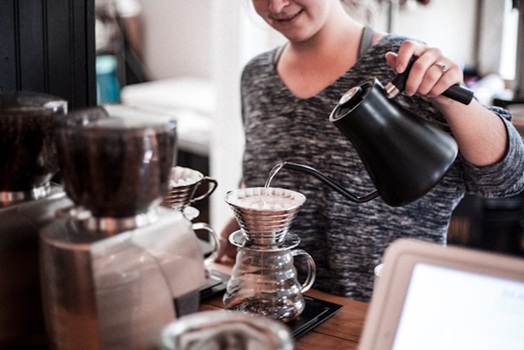
Coffee Competitions
In the 3rd wave coffee scene, baristas take center stage through global events like the World Barista Championship, Brewers Cup, Cup of Excellence, and many more. These competitions showcase extraordinary skill as baristas prepare and present coffees with surgical precision, explaining flavor notes and origin stories to judges.
Meanwhile, cupping scores—those numbers like “88 points” you see on specialty bags—come from professional tasters using the Specialty Coffee Association’s rigorous 100-point scale, evaluating everything from acidity to body[2].
Latte Art
Another fun part of third wave coffee is latte art. Baristas pour steamed milk into espresso with incredible precision, creating designs like rosettas, tulips, and swans that transform your morning caffeine fix into an Instagram-worthy moment.
The World Latte Art Championship[3] now draws competitors globally, with pioneers pushing boundaries with 3D designs and multiple-layer patterns on Lattes.
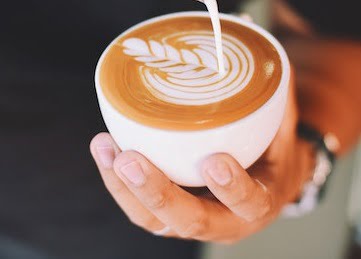
Aesthetic Cafes
3rd wave coffee isn’t just about the drink—it’s about the experience. You’ll walk into places like Blue Bottle, Intelligentsia, or Stumptown and immediately notice minimalist interiors with exposed brick, reclaimed wood, and industrial lighting that create a distinct sense of place.
These cafés design their spaces around the coffee experience, positioning brew bars front and center so you can watch baristas work their magic with pour-overs and espresso machines.
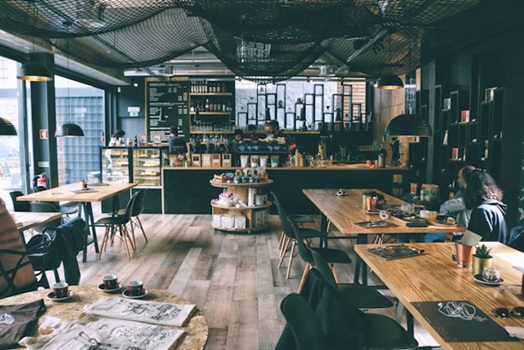
What were the First Wave and Second Wave of Coffee?
To fully understand the third wave, you need to know about the two waves that came before it.
First Wave Coffee
The first-wave of coffee spans around the 1800s to the early 1900s. It was all about making coffee easy to buy, store, and drink at home. This was when instant coffee and pre-ground coffee became common. Big brands like Folgers and Maxwell House made coffee a daily habit for many people.
Key features of first-wave coffee:
- Focused on mass production
- No Sustainable Practices and farmers were treated brutally
- Convenience over quality
- Usually, Pre-ground beans are sold
- Instant coffee became a household item
Taste and origin didn’t matter much in this wave. It was just a drink to help people wake up.
Second Wave Coffee
The second wave of coffee began in the mid-1900s. People started paying more attention to the taste of coffee. Big coffee shops like Starbucks and Peet’s Coffee turned coffee drinking into a social activity.
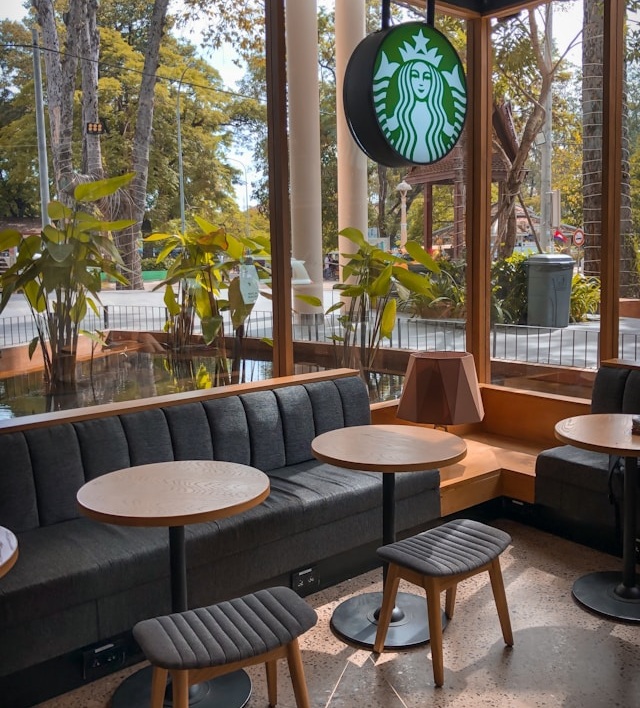
Key features of second-wave coffee:
- Intro of espresso-based drinks like lattes and cappuccinos
- Coffee shops became popular hangout spots
- Sweet Flavored coffees like vanilla, hazelnut, and caramel gained popularity.
- Coffee beans were often labeled by region (e.g., Colombian or Sumatran).
- Focus on bean origin and quality sourcing has become important to brands.
- Coffee Blends comes to the scene
- Better brewing methods like French press and pour-over
While quality improved, most second-wave coffee was still produced in large batches. The third wave took it even further.
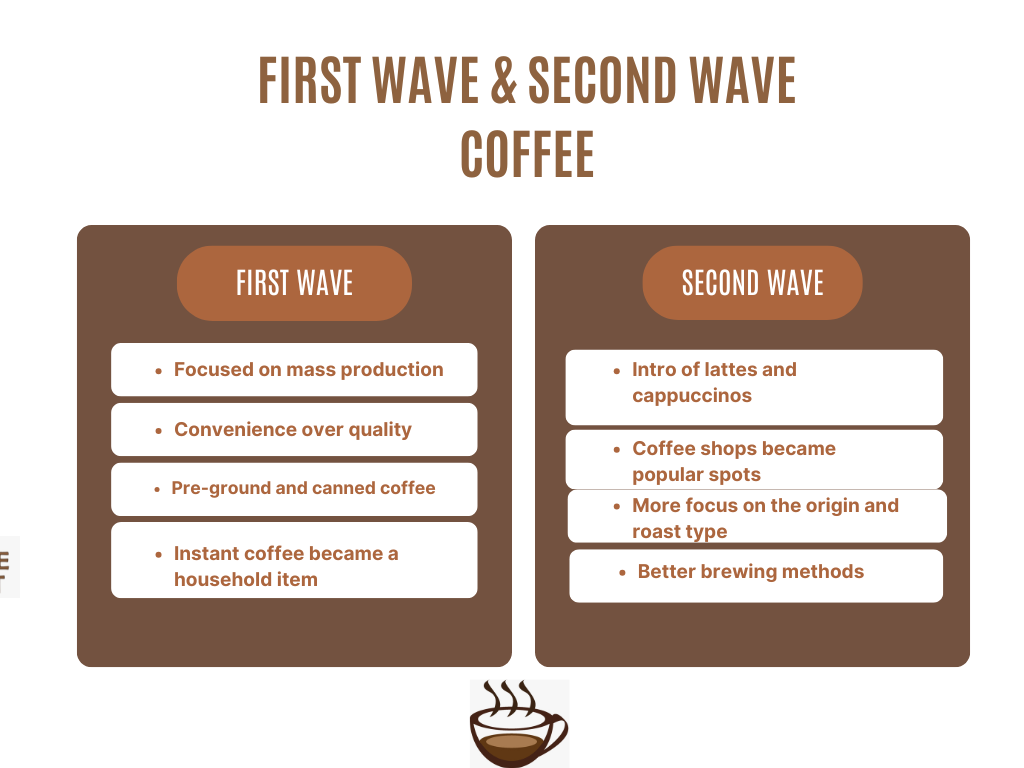
What is the difference between 3rd Wave and Specialty Coffee?
3rd wave coffee is all about treating coffee like a craft, focusing on quality and sustainability. Specialty coffee, on the other hand, refers to coffee that scores 80+ points on the Specialty Coffee Association’s 100-point scale. It’s a quality designation based on the beans themselves, with careful attention to defects, flavor profile, and growing conditions. The term actually predates the third wave and was coined back in the 1970s!
Think of specialty coffee as the high-quality ingredient, and third wave as a philosophy about how to source, roast, brew, and appreciate that ingredient.
What are the Best 3rd Wave Coffee Brands?
There are some great brands you can check out if you want to try real third wave coffee. These coffee roasters use high-quality beans, fair trade deals, and small-batch roasting to bring out the best flavors. They also use careful brewing methods for a better coffee experience.
Blue Bottle Coffee:
Blue Bottle Coffee stands out in the third wave coffee movement with its obsessive focus on freshness and quality. Blue Bottle sources only exceptional beans scoring 84+ on the specialty scale (above the standard 80-point minimum).
They maintain close relationships with farmers and pay well above Fair Trade prices. Their commitment shows in their small-batch roasting approach and quality control, with Q Grader-certified experts evaluating every coffee they source.
Stumptown Coffee Roasters
Stumptown helped shape the third-wave movement by focusing on direct trade long before it became a trend. They build strong relationships with farmers and pay premium prices for top-quality beans.
Stumptown roasts in small batches, using artisanal methods to bring out bold, rich flavors. Their cafes focus on transparency and education, often showcasing tasting notes and brewing tips so customers can fully appreciate the coffee journey.
What is the 4th Wave Coffee? Are we there?
Experts say the fourth wave of coffee is starting to take shape. It builds on the third wave’s love for quality and ethics but adds a stronger focus on technology and science.
Key Features of Fourth-Wave Coffee
Smart Brewing Technology: Smart brewing technologies and AI-powered coffee machines deliver consistently perfect cups by automatically adjusting parameters based on user preferences or bean characteristics.
Innovation in Coffee growing: Scientific research drives a deeper understanding of how soil health, climate, and plant genetics impact flavor and yield. And advanced Processing methods like controlled anaerobic fermentation and Honey Process are used to enhance flavor profiles with accuracy.
Transparency: Blockchain technology creates unprecedented farm-to-cup transparency, allowing consumers to verify ethical claims, payment fairness, and precise origin information with a simple scan.
Recent Developments:
- By using technologies like blockchain, companies are improving traceability in the coffee supply chain, ensuring ethical sourcing and fair compensation for farmers[4].
- Recent coffee makers are embracing 4th wave trends with AI-powered brewing, cold extraction tech, and at-home cafe level machines[5].
- As climate change threatens Arabica, researchers are turning to Robusta coffee, which is now thriving at higher altitudes, offering a resilient, climate-smart solution for the future[6].
Check Out Related Articles
- What is Organic Coffee
- Most Expensive Coffees in the World
- What is Fair Trade Coffee
- Washed Vs Natural Coffee
FAQs
Is Third Wave Coffee organic?
Some third wave coffee is organic, but not all of it. This movement focuses more on quality, fair trade, and unique flavors. You’ll find both inorganic and organic coffee options at third-wave coffee shops. But it depends on the farm and supplier. Always check the label if you want organic coffee.
Why is Third Wave Coffee so expensive?
Third wave coffee costs more because it uses higher-quality beans and employs more careful methods. The coffee comes from small farms that prioritize quality over quantity rather than from large factories. Farmers are paid reasonable prices for their hard work.
References:
- Comprehensive evaluation of volatile compounds and sensory profiles of coffee throughout the roasting process – ScienceDirect
- Specialty Coffee Association
- World Coffee Championships | World Latte Art Championship
- (PDF) A Harmonious Symphony of Fourth-Wave Coffee Culture: How The Relationship Between Coffee and Local Wisdom Contributes to Sustainability and Ethical Practices in Community
- We are definitely part of the 4th wave of coffee | De’Longhi
- Climate Change Drives Innovation in Coffee Production – Environment+Energy Leader
